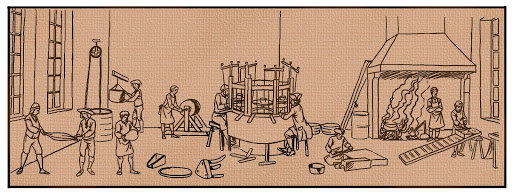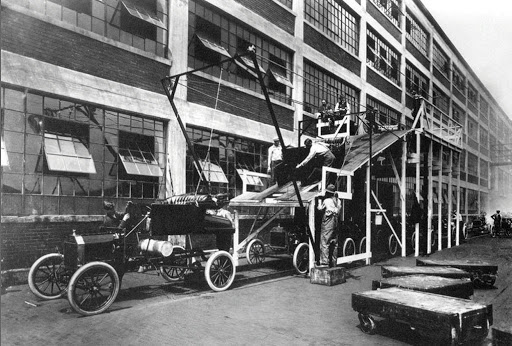Chapter 10: Executing Strategy through Organizational Design
10.3 The Basic Building Blocks of Organizational Structure
Legendary football coach Vince Lombardi once noted, “The achievements of an organization are the results of the combined effort of each individual.” Understanding how people can be most efficiently organized is the basis for modern management thought, and the building blocks of organizational structure are illustrated below.
|
Division of Labor |
Division of labor is a process of splitting up a task into a series of smaller tasks, each of which is performed by a specialist. In ancient Greece, historian Xenophon wrote about the division of labor in shoe making: one person cut out the shoes, another sewed the uppers together, and a third person assembled the parts. |
| Organizational Chart | An organizational chart is a diagram that depicts a firm’s structure. |
| Informal Linkages | Informal linkages are unofficial relationships such as friendships that do not appear in organizational charts. Examples are two department heads that build a relationship for better collaboration between their departments, a mentor relationship, or an experienced staff member taking a new employee “under their wing” to help them get off to a good start at the company. |
| Vertical Linkages | Vertical linkages tie supervisors and subordinates together. These linkages show the lines of responsibility through which a supervisor delegates authority to subordinates, oversees their activities, evaluates their performance, and guides them toward improvement. |
| Horizontal Linkages | Horizontal linkages are formal relationships between equals in an organization. They often take the form of committees and task forces. |
| Unity of Command | Employees may receive conflicting guidance about how to do their jobs if they work in a situation where multiple bosses are present. This problem can be avoided by following the unity of command principle, which states that each person should only report directly to one supervisor. |
Division of Labor
General Electric (GE), although downsized, still offers an array of products and services, including power generation, jet engines, medical equipment, and renewable energy. One way that GE could produce its jet engines would be to have individual employees work on one jet engine at a time from start to finish. However, this would be very inefficient so GE and most other organizations avoid this approach. Instead, organizations rely on division of labor when creating their products (Table 10.1). Division of labor is a process of splitting up a task (such as the creation of jet engines) into a series of smaller tasks, each of which is performed by a specialist.
Illustrated below is one of the oldest recorded stories from about 4300 years ago that is relevant to the design of modern organizations.
| Hierarchy of Authority Example: Moses | |
| After fleeing Egypt, Moses found himself as the sole judge of the entire Hebrew population. This was a daunting task because estimates suggest the population may have exceeded one million people. | Moses’s father-in-law, Jethro, warned Moses that he would wear himself out if he tried to handle such a heavy load alone. |
| Jethro offered Moses some practical advice. He told Moses that he should teach the people decrees and laws in an effort to minimize trouble and act as an example to demonstrate how the people live and the duties they were to perform. | Rather than handling all judging himself, Moses should appoint capable and trustworthy officials over groups of thousands, hundreds, fifties, and tens. These men would serve as judges for the people at all times, and only the most difficult cases would be brought to Moses. |
This is perhaps the first recorded example of a clear hierarchy of authority—an arrangement of individuals based on rank. A similar idea is used today in the US justice system where there are lower courts for easy-to-resolve cases and the Supreme Court only handles the most difficult cases.
The leaders at the top of organizations have long known that division of labor can improve efficiency. Thousands of years ago, for example, Moses’s creation of a hierarchy of authority by delegating responsibility to other judges offered perhaps the earliest known example (Table 10.2). In the eighteenth century, Adam Smith’s book The Wealth of Nations quantified the tremendous advantages that division of labor offered for a pin factory. If a worker performed all the various steps involved in making pins himself, he could make about twenty pins per day. By breaking the process into multiple steps, however, 10 workers could make 48,000 pins a day. In other words, the pin factory was a staggering 240 times more productive than it would have been without relying on division of labor. In the early twentieth century, Smith’s ideas strongly influenced Henry Ford and other industrial pioneers who sought to create efficient organizations.

While division of labor fuels efficiency, it also creates a challenge—figuring out how to coordinate different tasks and the people who perform them. The solution is organizational structure, which is defined as the process by which tasks are assigned and grouped together with formal reporting relationships. Creating a structure that effectively coordinates a firm’s activities increases the firm’s likelihood of success. Meanwhile, a structure that does not match well with a firm’s needs undermines the firm’s chances of prosperity.

Vertical and Horizontal Linkages
Most organizations use a diagram called an organizational chart to depict their structure. These organizational charts show how firms’ structures are built using two basic building blocks: vertical linkages and horizontal linkages. Vertical linkages tie supervisors and subordinates together. These linkages show the lines of responsibility through which a supervisor delegates authority to subordinates, oversees their activities, evaluates their performance, and guides them toward improvement when necessary. Every supervisor except for the person at the very top of the organizational chart also serves as a subordinate to someone else. In the typical business school, for example, a department chair supervises a set of professors. The department chair in turn is a subordinate of the dean.
Most executives rely on the unity of command principle when mapping out the vertical linkages in an organizational structure. This principle states that each person should only report directly to one supervisor. If employees have multiple bosses, they may receive conflicting guidance about how to do their jobs. The unity of command principle helps organizations to avoid such confusion. In the case of GE, for example, the head of the Energy division reports only to the chief executive officer. If problems were to arise with executing the strategic move discussed in this chapter’s opening vignette, joining the John Wood Group PLC with GE’s Energy division, the head of the Energy division would look to the chief executive officer for guidance.
Horizontal linkages are relationships between equals in an organization. These linkages are often called committees, task forces, or teams. Horizontal linkages are important when close coordination is needed across different segments of an organization. For example, most business schools revise their undergraduate curriculum every five or so years to ensure that students are receiving an education that matches the needs of current business conditions. Typically, a committee consisting of at least one professor from every academic area (such as management, marketing, accounting, and finance) will be appointed to perform this task. This approach helps ensure that all aspects of business are represented appropriately in the new curriculum.

The organic grocery store chain Whole Foods Market, owned by Amazon, is a company that relies heavily on horizontal linkages. As noted on their website:
At Whole Foods Market we recognize the importance of smaller tribal groupings to maximize familiarity and trust. We organize our stores and company into a variety of interlocking teams. Most teams have between 6 and 100 Team Members and the larger teams are divided further into a variety of sub-teams. The leaders of each team are also members of the Store Leadership Team and the Store Team Leaders are members of the Regional Leadership Team. This interlocking team structure continues all the way upwards to the Executive Team at the highest level of the company (Mackey, 2010).
This emphasis on teams is intended to develop trust throughout the organization, as well as to make full use of the talents and creativity possessed by every employee.
Informal Linkages
Informal linkages refer to unofficial relationships such as personal friendships, rivalries, and politics. In the long-running comedy series The Simpsons, Homer Simpson is a low-level, low-performing employee at a nuclear power plant. In one episode, Homer gains power and influence with the plant’s owner, Montgomery Burns, which far exceeds Homer’s meager position in the organization chart, because Mr. Burns desperately wants to be a member of the bowling team that Homer captains. Homer tries to use his newfound influence for his own personal gain and, naturally, the organization as a whole suffers. Informal linkages such as this one do not appear in organizational charts, but they nevertheless can have (and often do have) a significant influence on how firms operate.
Section Video
Organizational Design and Structure [02:44]
The video for this lesson explains the process of organizational design and its structure.
You can view this video here: https://youtu.be/Y4vEos6xuks.
Key Takeaway
- The concept of division of labor (dividing organizational activities into smaller tasks) lies at the heart of the study of organizational structure. Understanding vertical, horizontal, and informal linkages helps managers to organize better the different individuals and job functions within a firm.
Exercises
- How is division of labor used when training college or university football teams? Do you think you could use a different division of labor and achieve more efficiency?
- What are some formal and informal linkages that you have encountered at your college or university? What informal linkages have you observed in the workplace?
References
Mackey, J. (2010, March 9). Creating the high trust organization. Whole Foods Market. https://www.wholefoodsmarket.com/tips-and-ideas/archive/creating-high-trust-organization.
Image Credits
Figure 10.4: Ford Company. “1913 photograph Ford company, USA.” Public Domain. Retrieved from https://en.wikipedia.org/wiki/File:A-line1913.jpg.
Figure 10.5: Christina @ wocintechchat.com (2019). CC-BY SA 2.0. Cropped. Retrieved from https://unsplash.com/photos/rg1y72eKw6o.
Video Credits
Gregg Learning. (2019, January 10). Organizational design and structure [Video]. YouTube. https://youtu.be/Y4vEos6xuks.

